Works in progress: performance
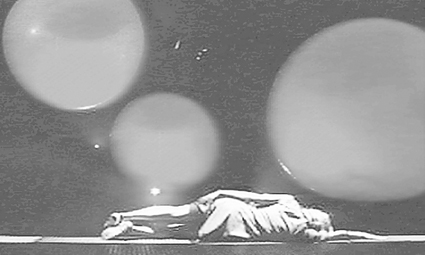
Arena Theatre Company, Eat Your Young
Eat Your Young
Arena Theatre Company
A lush, futuristic action adventure set in a privatised fully automated institution for minors in state care. Three children struggle to stay together in a climate of rapid change, a culture of fear where the young have come to represent the perpetrator, the icon of a society out of control.
The screen is often used as a backdrop in performance, but a performance that truly engages notions of screen culture in its evolution is much more challenging. Eat Your Young plays with the notion of real time by creating inherent formal questions in the viewing of the work. These questions are asked via a seamless vision mixing between the projected pre-recorded and live image (shot on robotically controlled tracking to allow precision repetition of X and Y axis pathways through space and time), design integration, live and pre-recorded vocal dub, computerised show control and continued use of mixed high tech and low tech aesthetic allowing effect and machination to be read simultaneously. Main challenges—our appetite exceeds our purse, clarity of dialogues across collaborators.
Arena Theatre Company aims to create multidisciplined performances that reflect the complex multiple nature of human experience. Arena’s manifesto cites young audiences at the fore of new cultural expression, fluid in their skills of deconstruction and symbolic comprehension. Recent work includes the anthroPOP trilogy AUTOPSY, MASS and PANACEA. Winners of the 1999 ASSITEJ International Honorary Presidents Award.
Completion March 2000. Arena is funded triennially by the Australia Council Theatre Fund and annually Arts Victoria.
Triple Alice
Tess de Quincey
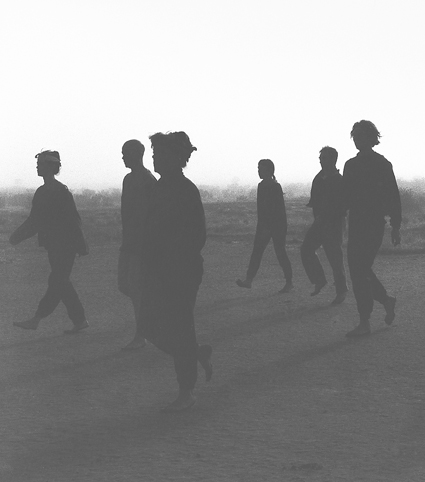
Lake Mungo, 1991
photo Heidrun Löhr
Lake Mungo, 1991
A gathering in hard space and virtual space, Triple Alice engages with Australia’s Central Desert as a burning point in its mapping of the future of artistic, cultural and media practice. Held over three years 1999 – 2001, Triple Alice convenes a forum and three live, site and temporally-specific laboratories staged over three weeks each year.
We are finding that remote broadcast and networking demands a cultural delicacy but also a technical capacity which as yet is under-resourced in its ability to meet the vision of this event. The KOZ online Community Publishing System will be fundamental to the project. Linked to the main site, KOZ creates an online congregation minus html phobia, and gives each visitor or, rather, ‘online resident’ their own web page and email address.
Triple Alice is initiated by Tess de Quincey, current recipient of the Australia Council Choreographic Fellowship. She has worked extensively in Japan, Europe, India and Australia as solo performer, teacher and director.
Triple Alice is a partnership between BodyWeather, Desart, Centre for Performance Studies (University of Sydney) and The Performance Space.
www.triplealice.net [expired] September 20 – October 10. Workshop component Australia Council funded.
Humanoids in progress
Arthur Wicks
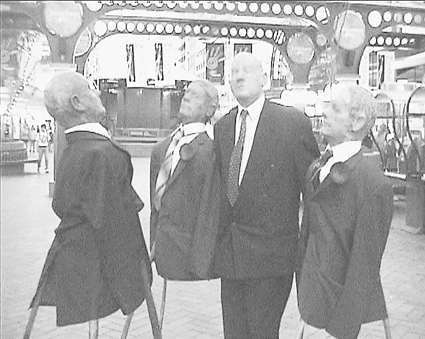
Arthur Wicks, Humanoids in progress
This is the early stage of a mixed media work where a group of “humanoids” are mobilised by remote control. The next stage of the project is to implant sensors which respond to a variety of inputs. The humanoids will then be able to interact relatively independently with an audience. Control of the physical servo mechanisms will be through a series of micro processors programmed to relate sensor input to specific physical responses. This phase of the project requires collaboration with an electronic engineer and the testing of stronger and more intricate physical servo mechanisms (such as those used in aerodynamics). This will enable the humanoid to perform more intricate physical responses over a longer period. Project time frame approximately 1999 – 2002.
Arthur Wicks has been involved with performance since the early 1970s. More recent works have involved the construction of machines which are “barely engineered, nearly built, narrowly operative. They teeter on the edge of collapse.” (David Hansen on Wicks’ Last Work,The Daily Advertiser, 1992)
Tower of Light
Melbourne Workers Theatre, The Institute of Complex Entertainment
Tower of Light explores gaming culture and corporate responsibility in a world where winning is everything and losing is invisible. It incorporates live performance and music, community groups, large scale puppetry and soundscape with projected digital video, slide and other electronic media. Director Susie Dee, visual media designer Chris Harris and lighting designer Nathan Thompson explore the role of immersive media spectacle in creating the illusory promise of gaming culture. They have been working in close collaboration with the writer, musical director and set designer to create an environment of images designed not only to seduce and dislocate, but also provide another effective layer of truthful communication within the performance itself.
The challenge for the creative team has been to use technology to build an environment of light and projection which successfully interacts with all the other elements and maintains the performance’s integrity.
Chris Harris studied sculpture at the SA School of Art and was a core creative member of desoxy Theatre for four years. He now works in Melbourne as theatrical stage and projection designer and a production manager. Nathan Thompson runs The Flaming Beacon, a small lighting design office in Melbourne. He has created lighting designs for performance, architecture and new media in projects on 5 continents. His recent piece with Christian Möeller, Audio Grove, installed at the Spiral Gallery Tokyo won a prize at last year’s Prix Ars Electronica and was re-mounted for Cyber 98 in Lisbon.
October 17 – 30, Melbourne Festival, Royal Melbourne Showgrounds. New media component funded by New Media Arts Fund, Australia Council
White Collar Project
Nerve Shell
A sound/performance installation to take place on a rooftop site in Sydney’s CBD. A hybrid of telecommunication devices, dance, spoken word, film and soundtrack. The audience, issued with personalised aural receivers, will experience a relayed series of live mixed and ever changing events emanating from remote performance sites. Primarily driven by the sound, the performance will implicate the invisible traces of the digitalised human and the gridded exchanges of the millennial city.
Among the challenges for White Collar Project are ways to immerse the spectator in a constructed world using real architecture, sights and sounds in a responsive way so that the prefabricated elements spark ‘incidents.’ Some of the challenges will be purely practical: negotiating fierce environments for access to city space during 2000; sourcing the most flexible technology: and interlacing, through live mixing, all the strands of this experience.
Nerve Shell is Caitlin Newton-Broad and Gail Priest. Together they created Dead Girls’ Party (The Performance Space Gallery 1997), a sound performance installation exploring the lost lives of famous artists’ wives. Caitlin is a writer/director. Gail is a sound designer/performance artist. Other artists contributing to this event include Samuel James, Shane Wynter, Regina Heilmann, Joel Markham and Ben Rogan.
April 2000. New Media Arts Fund, Australia Council
To Eat Flowers and Walk on Glass
Salamanca Theatre Company & syt (salamanca youth theatre)
A performance and installation with video,To Eat Flowers and Walk on Glass resulted from an 8 week creative development process involving STC artistic director Deborah Pollard, guest installation artist from Indonesia Hedi Hariyanto, Sean Bacon, Sally Rees, Poonkhin Khut and other emerging Hobart artists. The title is inspired by the Javanese trance dance called Jatilan in which the male dancer falls into trance and become possessed by horse spirits. The horse spirits are fed flower petals. The project will examine the many subcultures that exist within contemporary youth culture and compare them to some traditional counterparts.
The work will stylistically explore the interface of live action (tattooing and piercing) in relation to pre-recorded and live video. The ability of the video eye to digitally bring the action to a scale that is larger than life will be pitted against the effect of real action in real time. The installation will take place over 4 hours. Just as a tattoo slowly transfigures the body, video installations will create an atmosphere of constant transition as they imperceptibly change over the course of the work. A constant beat drawn from myriad trance cultures will continuously build and subside. The sound installation comprises live mixing and percussion.
CAST Gallery, Friday 27 August. Hedi Hariyanto courtesy of an artist-in-residence program, University of Tasmania. Australia Council, Arts Tasmania; with support from CAST (Contemporary Art Services Tasmania).
States Of Kinship
Doppio-Parallelo, Sustenance Productions
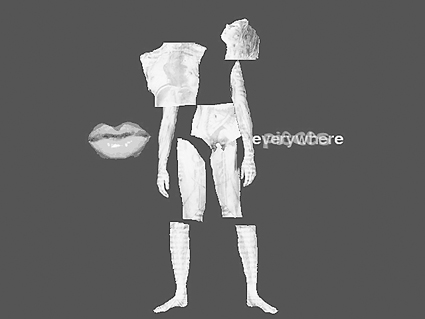
Lynne Sanderson, States of Kinship
States of Kinship was created as an adjunct to Doppio-Parallelo’s live theatre performance of the same name, written by Melina Marchetta. Based on a journey of cultural/personal discovery, the website relates to the rites of passage of the main character, Francesca. Enhanced by animated images and sound, the user explores her inner world. The script is set someplace between sleep and waking, between the physical dimension of live performance and the virtual space accessed via technology.
Beyond the technical difficulties of multiple platforms and browser differences was the challenge of condensing and distilling the essence of the script into a website to complement the live performance. We wanted to look at new approaches to performance writing and ways of engaging our communities in both urban and rural centres. In 1998 we brought a national group of cultural workers to our On Contested Ground public seminar at Ngapartji Multimedia Centre to discuss the notions of kinship, memory and racism—themes that are influencing our work over the next few years. Discussions were held with both real and online communities about what these issues mean to them today in Australia.
With the support of the Australian Film Commission, Ngapartji, Media Resource Centre and Australian Network for Art & Technology, a research group called Rosebud was established to undertake study regarding narrative and interactivity for performance. This group would later inform the practice for the States of Kinship project.
As Sustenance Productions, Lynne Sanderson (Digital Artist) and Peter Sansom (Sound Designer/Composer), have collaborated on computer animations Need and Primal Debug which have been exhibited extensively including MTV Australia and the touring exhibition An Eccentric Orbit which opened at MoMA, NYC and is currently touring nationally. Other works include the multi-screen installation …mutant!… exhibited at the EAF and the website Somnolent Fantasies (www.unisa.edu.au/sleep/art/title.html) created during a residency at the Centre for Sleep Research, Queen Elizabeth Hospital, Adelaide. http://sustenance.va.com.au/-Sustenance Productions
www.doppio-parallelo.on.net [expired] States of Kinship, the performance, July 26 – August 7 1999, EDS Centre, North Terrace, Adelaide. Australia Council and ArtsSA.
Monster Mouth
Dina Panozzo
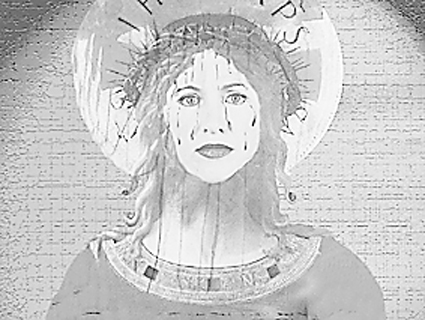
Dina Panozzo, Monster Mouth
A live performance with CD-ROM. In a state of psychic torment, a woman searches the internet for spiritual guidance. Along the way she encounters a female Jesus, a ghost turned body snatcher and finally her own personal apocalypse.
For the writer the challenges have included negotiating the different languages of computer graphics and text for a live performance. A sketch for a scene involving the snatching of my body almost wrote itself when I saw Maria Miranda’s images. For Maria, creating a trashy net-like world as well as a set of surreal images for large scale projection meant stretching the capacity of her low-end equipment to the limit: “For this scale of projection it’s all silicon graphics these days, but I enjoyed pushing Photoshop to do something wilder than normal. And the fact that the work is not timed for an interactive user but for an audience watching a live performance has sometimes meant more precision in the design.” Yet to be encountered is the challenge of Greg White’s programming and his sound design as they relate to the rhythms of spoken language and Elena Katz-Chernin’s music, followed by the interactions of live performer, a very large screen and an audience.
Dina Panozzo is a performer and writer living in Sydney. Her performance work with live video camera, Varda Che Bruta…Poretta (Look how ugly she is, poor thing) was produced with Open City in 1995, premiered in Sydney and toured to Adelaide and Melbourne.
Creative development of the CD-ROM component funded by the New Media Arts Fund, Australia Council. Dramaturgy and administration, Open City. Additional support from Playworks.
RealTime issue #32 Aug-Sept 1999 pg. 15






